Connect With Us
Blog
Items filtered by date: March 2023
Reminder: When Was the Last Time...?
Can Poor Circulation Be Improved?
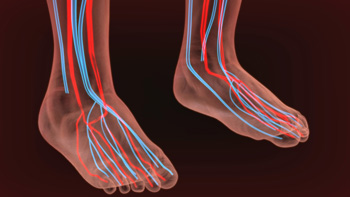
One of the symptoms of poor circulation is cold feet. This may be an indication of existing health concerns such as blood clots, chronic pain, and mobility issues. Additional signs of this condition can include swollen feet, tingling sensations, increased fatigue, and the feet may feel heavy. There are various reasons why patients may develop poor circulation. These can consist of being overweight, having a sedentary lifestyle, and the aging process. Poor circulation can also be caused by existing medical conditions, including diabetes, peripheral artery disease (PAD), or atherosclerosis, which is hardening of the arteries. There are methods that can be implemented which may help to improve poor circulation. It is important to move as much as possible by performing low-impact activities, and walking, yoga, and swimming fit into this category. Patients who are unable to do this may benefit from having physical therapy performed, or possibly from using a cane or walker. Eating foods that are healthy may help to improve circulation, in addition to frequently elevating the feet. If you would like more information about efforts to improve circulation, it is suggested that you consult with a podiatrist.
While poor circulation itself isn’t a condition; it is a symptom of another underlying health condition you may have. If you have any concerns with poor circulation in your feet contact one of our podiatrists of Fox Valley Foot and Ankle Specialists. Our doctors will treat your foot and ankle needs.
Poor Circulation in the Feet
Peripheral artery disease (PAD) can potentially lead to poor circulation in the lower extremities. PAD is a condition that causes the blood vessels and arteries to narrow. In a linked condition called atherosclerosis, the arteries stiffen up due to a buildup of plaque in the arteries and blood vessels. These two conditions can cause a decrease in the amount of blood that flows to your extremities, therefore resulting in pain.
Symptoms
Some of the most common symptoms of poor circulation are:
- Numbness
- Tingling
- Throbbing or stinging pain in limbs
- Pain
- Muscle Cramps
Treatment for poor circulation often depends on the underlying condition that causes it. Methods for treatment may include insulin for diabetes, special exercise programs, surgery for varicose veins, or compression socks for swollen legs.
As always, see a podiatrist as he or she will assist in finding a regimen that suits you. A podiatrist can also prescribe you any needed medication.
If you have any questions, please feel free to contact our office located in Naperville, IL . We offer the newest diagnostic and treatment technologies for all your foot care needs.
Blisters and Shoes Without Socks
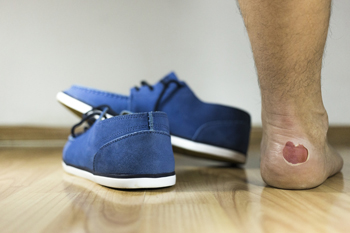
Blisters can form on the feet for a variety of different reasons. Blisters, once they develop, can take form as pockets of fluid on the outer layer of the skin. Often, blisters can form on the feet in response to friction or pressure. Commonly, pain and blisters can form when an individual wears summer shoes without any socks. This can be particularly pronounced when wearing leather shoes without socks. To avoid this problem, an individual can take a number of different steps. For example, an individual can wear ankle socks which are not visible from the outside, yet they can effectively protect the feet from the development of blisters on the foot inside of the shoe. If you are someone that likes to wear shoes without any socks, it is highly suggested that you consider contacting a podiatrist to schedule an appointment.
Blisters are prone to making everyday activities extremely uncomfortable. If your feet are hurting, contact one of our podiatrists of Fox Valley Foot and Ankle Specialists. Our doctors can provide the care you need to keep you pain-free and on your feet.
Foot Blisters
Foot blisters develop as a result of constantly wearing tight or ill-fitting footwear. This happens due to the constant rubbing from the shoe, which can often lead to pain.
What Are Foot Blisters?
A foot blister is a small fluid-filled pocket that forms on the upper-most layer of the skin. Blisters are filled with clear fluid and can lead to blood drainage or pus if the area becomes infected.
How Do Blisters Form?
Blisters on the feet are often the result of constant friction of skin and material, usually by shoe rubbing. Walking in sandals, boots, or shoes that don’t fit properly for long periods of time can result in a blister. Having consistent foot moisture and humidity can easily lead to blister formation.
Prevention & Treatment
It is important to properly care for the affected area in order to prevent infection and ease the pain. Do not lance the blister and use a Band-Aid to provide pain relief. Also, be sure to keep your feet dry and wear proper fitting shoes. If you see blood or pus in a blister, seek assistance from a podiatrist.
If you have any questions, please feel free to contact our office located in Naperville, IL . We offer the newest diagnostic and treatment technologies for all your foot care needs.
My 2nd Toe Hurts
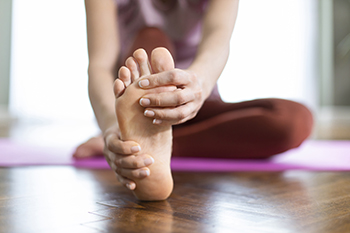
The second toe might cause pain or discomfort if it is injured, or if one suffers from a chronic condition. One such condition is called capsulitis. This can cause irritation and inflammation at the base of the second toe. One might feel swelling in the toes, have trouble putting on or wearing shoes, and have pain at the ball of the foot that worsens when walking barefoot. It may feel like one is walking on a marble or that the sock is bunched up under the foot. Commonly, capsulitis results from improper foot mechanics, with the ball of the foot withstanding excess pressure. Metatarsalgia is another condition that causes pain in the ball of the foot that may be concentrated under the second toe. This often begins as a callus on the bottom of the foot, and it can put pressure on nerves and other structures around the toe. Another cause of second toe pain is an ingrown toenail. This is when the toenail is embedded into the skin of the toe. It can make the toe sensitive to the touch and sore. Since second toe pain can arise from different causes, it is suggested that you seek the counsel of a podiatrist who can help you identify the cause of your pain and offer treatment solutions.
Toe pain can disrupt your daily activities. If you have any concerns, contact one of our podiatrists of Fox Valley Foot and Ankle Specialists. Our doctors can provide the care you need to keep you pain-free and on your feet.
What Causes Toe Pain?
Most severe toe pain is caused due to a sports injury, trauma from dropping something heavy on the toe, or bumping into something rigid. Other problems can develop over time for various reasons.
Toe pain can be caused by one or more ailments. The most common include:
- Trauma
- Sports injury
- Wearing shoes that are too tight
- Arthritis
- Gout
- Corns and calluses
- Hammertoe
- Bunions
- Blisters
- Ingrown toenails
- Sprains
- Fractures (broken bones)
- Dislocations
When to See a Podiatrist
- Severe pain
- Persistent pain that lasts more than a week
- Signs of infection
- Continued swelling
- Pain that prevents walking
Diagnosis
In many cases the cause of toe pain is obvious, but in others, a podiatrist may want to use more advanced methods to determine the problem. These can range from simple visual inspections and sensation tests to X-rays and MRI scans. Prior medical history, family medical history, and any recent physical traumatic events will all be taken into consideration for a proper diagnosis.
Treatment
Treatments for toe pain and injuries vary and may include shoe inserts, padding, taping, medicines, injections, and in some cases, surgery. If you believe that you have broken a toe, please see a podiatrist as soon as possible.
If you have any questions please feel free to contact our office located in Naperville, IL . We offer the newest diagnostic tools and technology to treat your foot and ankle needs.
What Is the Brannock Device?
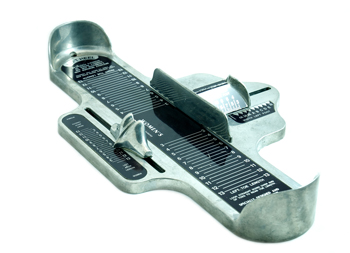
Few people know that the name of the foot measuring device in most shoe stores and departments is called the Brannock device. It was invented in 1925 by Charles Brannock, who worked in a shoe store and discovered that determining customers' proper shoe size was difficult. The Ritz Stick was its predecessor, which was simply a fancy wooden ruler that measured the length of the feet and then had to be repositioned to measure the width. Brannock’s goal was to develop a device to measure both the length and width of the foot at the same time, hence the Brannock device. This device changed the course of history and helped scores of people determine their correct shoe size. Since then, more high-tech ways of measuring the feet are available in some shoe stores, such as scanners in athletic shoe stores. Not wearing properly fitted shoes can result in a host of foot problems. Measuring both feet is critical before buying new shoes and beyond that, making sure they are comfortable from the get-go is important. If you need help determining your correct shoe size, it is suggested that you consult with a podiatrist for assistance.
Finding a properly-fitting shoe is important in reducing injuries and preventing foot problems. For more information about treatment, contact one of our podiatrists from Fox Valley Foot and Ankle Specialists. Our doctors will treat your foot and ankle needs.
Proper Shoe Fitting
A common concern when it comes to foot health, having properly fitted shoes can help prevent injuries to the foot. Out feet affect our posture and gait, which in turn affects the biomechanics and overall bodily structure. With 33 joints, 26 bones, and over 100 ligaments, the potential for serious injury is much greater than one realizes. Although the feet cease growth in adulthood, they still change shape as they mature. Here are some factors to consider when it comes to investing in proper fitting shoes:
- Be sure the shoes fit correctly right away
- Ensure the ball of your foot fits comfortably in the widest portion of the shoes
- Even though they may look fashionable, improper fitting shoes can either create adverse conditions or exacerbate existing ones you may already have
- Walk along a carpeted surface to ensure the shoes comfortably fit during normal activity
Keeping in mind how shoes fit the biomechanics of your body, properly-fitting shoes are vitally important. Fortunately, it is not difficult to acquire footwear that fits correctly. Be sure to wear shoes that support the overall structure of your body. Do your feet a favor and invest in several pairs of well-fitted shoes today.
If you have any questions please feel free to contact our office located in Naperville, IL . We offer the newest diagnostic and treatment technologies for all your foot and ankle needs.
What Can Lead To Morton’s Neuroma?
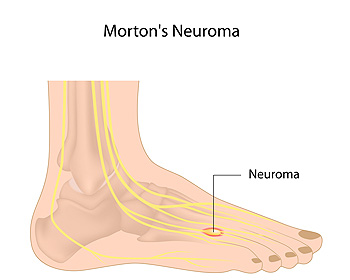
There are nerves in the foot referred to as plantar digital nerves. The foot condition known as Morton’s neuroma affects the nerves that run between the third and fourth toes. This nerve can become compressed from wearing shoes that are tight in the toe area, for example, high heels. Foot deformities such as bunions and hammertoes may also lead to the development of Morton's neuroma. This condition may also occur if there has been a foot or nerve injury, weakness in the foot muscles, or from standing for extended periods. Relief may be found when the pressure that affected the nerve is ceased. This can be accomplished by wearing flat shoes, shoes with a low heel, or cushioned insoles. In severe cases, to eliminate the pain, surgery may be necessary to remove the nerve. If you have Morton’s neuroma, it is strongly suggested that you seek the counsel of a podiatrist who can determine what the best type of treatment is for you.
Morton’s neuroma is a very uncomfortable condition to live with. If you think you have Morton’s neuroma, contact one of our podiatrists of Fox Valley Foot and Ankle Specialists. Our doctors will attend to all of your foot care needs and answer any of your related questions.
Morton’s Neuroma
Morton's neuroma is a painful foot condition that commonly affects the areas between the second and third or third and fourth toe, although other areas of the foot are also susceptible. Morton’s neuroma is caused by an inflamed nerve in the foot that is being squeezed and aggravated by surrounding bones.
What Increases the Chances of Having Morton’s Neuroma?
- Ill-fitting high heels or shoes that add pressure to the toe or foot
- Jogging, running or any sport that involves constant impact to the foot
- Flat feet, bunions, and any other foot deformities
Morton’s neuroma is a very treatable condition. Orthotics and shoe inserts can often be used to alleviate the pain on the forefront of the feet. In more severe cases, corticosteroids can also be prescribed. In order to figure out the best treatment for your neuroma, it’s recommended to seek the care of a podiatrist who can diagnose your condition and provide different treatment options.
If you have any questions, please feel free to contact our office located in Naperville, IL . We offer the newest diagnostic and treatment technologies for all your foot care needs.

